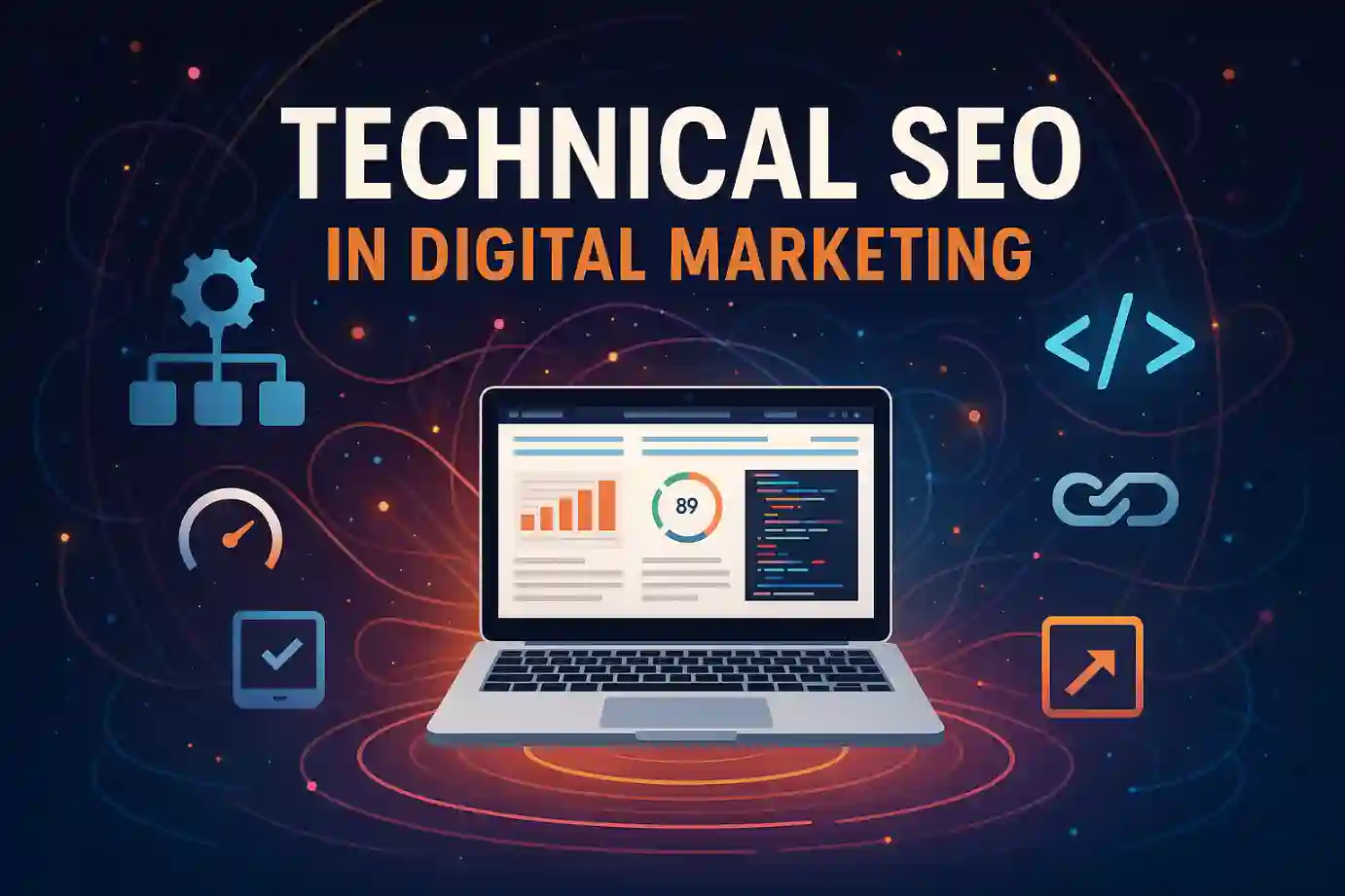What Is Technical SEO in Digital Marketing?
At Vibe Branding, we’ve been doing this for over a decade. One thing we’ve learned from helping hundreds of clients grow their online presence is that technical SEO in digital marketing is not optional—it’s essential.
While many people jump straight into content or backlinks, they often overlook the backend factors that determine whether a site will even be found. Technical SEO refers to the optimization of your website’s infrastructure.
It’s everything that happens under the hood—like improving load speeds, creating logical site structures, optimizing for mobile, and ensuring that search engines can crawl and index your site efficiently. Without it, all your creative content and keyword-rich blogs don’t stand a chance at ranking.
TL;DR
- Technical SEO is the foundation of a high-performing website.
- It ensures your content is accessible, crawlable, and indexable.
- Key elements include site speed, mobile-friendliness, HTTPS, and structured data.
- Internal linking and site architecture guide search engines and users alike.
- Even without a dev team, solo marketers and small businesses can implement essential technical SEO practices.
Why Technical SEO is the Foundation of Your Digital Strategy
When we onboard a client at Vibe Branding, one of the first things we analyze is their technical SEO health. It’s not just about fixing broken links or resizing images.
It’s about laying a solid digital foundation so all other SEO efforts can succeed. A fast, crawlable, and secure website impacts:
- Search Rankings: Google has made it clear—technical performance affects your visibility.
- User Experience: A slow, disorganized website sends users packing.
- Conversions: Fast, well-structured sites keep users engaged longer.
- Indexability: If your site can’t be indexed, it won’t show up—period.
- Scalability: Good technical SEO allows your site to grow without breaking.
Think of technical SEO as the plumbing and wiring in a new home. You can decorate all you want, but if the essentials aren’t there, nobody’s living in it.

The Most Important Technical SEO Factors in 2025
As of this year, we’ve seen Google double down on the following technical SEO priorities. These aren’t just trends—they’re the new normal.
- Core Web Vitals: Google’s user-centric metrics (LCP, FID, CLS) now directly affect rankings. Sites that meet these thresholds are getting preference in search.
- Mobile-First Indexing: If your site isn’t responsive and mobile-optimized, Google treats it as broken.
- HTTPS and Security: Not having an SSL certificate? You’re already behind.
- Structured Data and Schema: This is what enables rich results—like star ratings, product prices, and event listings.
- Crawl Budget Optimization: Efficient internal linking, canonical tags, and sitemap accuracy help Google crawl your site faster and smarter.
We track and fine-tune all these elements regularly through tools like Google Search Console and Screaming Frog. Trust us, staying on top of these factors keeps our clients’ rankings competitive.
Speed, Mobile-Friendliness & Core Web Vitals: Your SEO Lifeline
Let’s talk speed. Google research shows that if a page takes longer than 3 seconds to load, 53% of users will bounce.
That’s not just lost traffic—it’s lost revenue. And when mobile accounts for over 60% of web traffic, slow or unoptimized mobile pages are silent killers.
That’s why we conduct regular Lighthouse audits. Here’s what we look for:
Metric | Ideal Threshold | Why It Matters |
LCP (Load Time) | < 2.5s | Affects first impression and UX |
FID (Interaction Time) | < 100ms | Indicates responsiveness |
CLS (Visual Stability) | < 0.1 | Prevents layout shifts that frustrate |
We recommend compressing images, using lazy loading, and implementing proper caching. These are relatively easy wins that drastically improve performance.
Tools to Audit and Improve Technical SEO
You don’t need to be a developer or SEO wizard to start improving your technical SEO in digital marketing. Over the years, we’ve streamlined our go-to stack of tools.
Here’s what we trust and use regularly:
- Google Search Console: Free insights straight from the source. Crawl errors, indexing issues, and performance data all in one place.
- Screaming Frog: Perfect for finding broken links, redirect issues, and duplicate content.
- PageSpeed Insights: Google’s own tool to diagnose site speed and suggest fixes.
- Ahrefs/Semrush: Great for technical audits, especially for enterprise clients.
- Yoast SEO / Rank Math: If you’re using WordPress, these plugins simplify structured data, robots.txt, and sitemaps.
Even our clients with minimal tech know-how have made big gains just by running these tools monthly.

How Technical SEO Impacts Indexing and Discoverability
Content is king—but only if it’s visible to search engines. That’s why technical SEO plays a huge role in discoverability.
From proper use of canonical tags to eliminating crawl errors, your site’s structure dictates whether your content even has a shot at being indexed. In our early years at Vibe Branding, we worked with a client who had hundreds of blogs.
None of them were ranking. Why?
Their sitemap was broken, and they had blocked Googlebot in their robots.txt. Within 30 days of fixing both, their impressions tripled.
That’s the power of technical SEO.
Avoiding Common Technical SEO Mistakes
Mistakes happen. But when it comes to technical SEO, some missteps can tank your entire digital strategy.
Here are the biggest ones we see:
- Not redirecting after moving to HTTPS: Causes duplicate content and lost traffic.
- Disorganized URL structures: Hurts crawlability and confuses users.
- Orphan pages: Pages without internal links are nearly invisible to search engines.
- Bloated plugins: On WordPress, too many plugins slow down your site.
- Improper canonicalization: Creates duplicate content issues.
We encourage clients to perform quarterly SEO audits. It’s like a health checkup for your website.
Catching issues early means avoiding bigger, more expensive problems down the road.
Structured Data and Schema: Visibility Superchargers
Structured data is one of the most underrated weapons in technical SEO. It tells search engines what your content means—not just what it says.
Using JSON-LD format, we can implement schema markup for:
- Articles
- Products
- Events
- FAQs
- Reviews
At Vibe Branding, we’ve seen clients’ click-through rates rise by over 25% simply from getting rich snippets. They stand out in search results, which naturally draws more attention.
Implementing schema is no longer a “nice to have”—it’s a must.

Why Internal Linking and Website Architecture Matter
Your site’s structure and internal links guide both search engines and human visitors. A clear hierarchy allows Google to understand which pages are most important.
Without this, even your best content might go unnoticed. Here’s how we approach it:
- Every new blog post links to 2-3 relevant internal pages
- We maintain siloed content clusters around core services
- Navigation is consistent and logical across devices
- Breadcrumbs and footers support deeper exploration
- Broken links are fixed monthly using audit tools
When we optimized the internal linking structure for one of our clients in the education space, organic traffic jumped 40% in 60 days. That’s the kind of impact architecture can have.
How Small Businesses and Solo Marketers Can Do Technical SEO
You don’t need a dev team or an SEO agency to get started. If you’re a solo marketer or running a small business, there are still plenty of practical things you can do to improve technical SEO in digital marketing.
Start with this checklist:
- Use a reliable CMS like WordPress with SEO plugins
- Install an SSL certificate (often free from your hosting provider)
- Create and submit a sitemap to Google Search Console
- Optimize images before uploading (use TinyPNG or Squoosh)
- Use responsive design templates or themes
With just 3-5 hours a month, you can make significant progress. Over time, your site will get faster, more organized, and more visible.
We’ve helped dozens of small businesses start this way and then scale their SEO efforts as they grow.
Final Thoughts
We’ve only scratched the surface here. But if there’s one thing I want you to take away, it’s this: technical SEO in digital marketing isn’t just for developers.
It’s for anyone who wants their website to perform better, rank higher, and convert more. Whether you’re just starting out or optimizing an established site, technical SEO deserves your attention.
In the next section, we’ll look at how to measure your progress, monitor your results, and build a roadmap for long-term SEO growth. Stay tuned for the final installment of this comprehensive guide.





